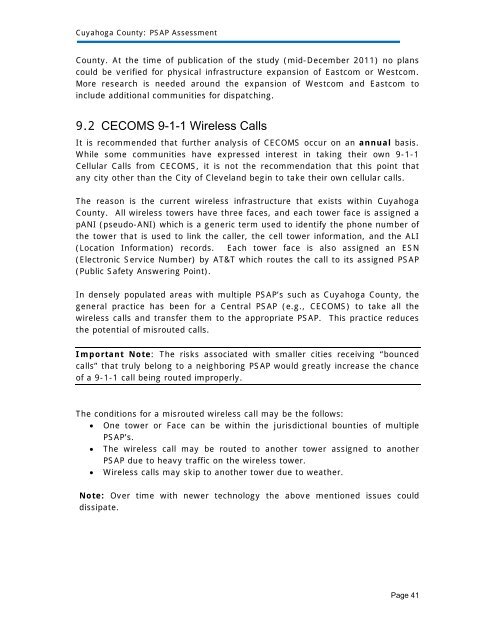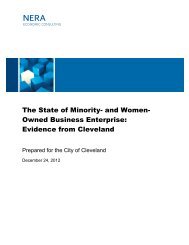Cuyahoga County: Public Safety Answering Point ... - Cleveland.com
Cuyahoga County: Public Safety Answering Point ... - Cleveland.com
Cuyahoga County: Public Safety Answering Point ... - Cleveland.com
You also want an ePaper? Increase the reach of your titles
YUMPU automatically turns print PDFs into web optimized ePapers that Google loves.
<strong>Cuyahoga</strong> <strong>County</strong>: PSAP Assessment<br />
<strong>County</strong>. At the time of publication of the study (mid-December 2011) no plans<br />
could be verified for physical infrastructure expansion of East<strong>com</strong> or West<strong>com</strong>.<br />
More research is needed around the expansion of West<strong>com</strong> and East<strong>com</strong> to<br />
include additional <strong>com</strong>munities for dispatching.<br />
9.2 CECOMS 9-1-1 Wireless Calls<br />
It is re<strong>com</strong>mended that further analysis of CECOMS occur on an annual basis.<br />
While some <strong>com</strong>munities have expressed interest in taking their own 9-1-1<br />
Cellular Calls from CECOMS, it is not the re<strong>com</strong>mendation that this point that<br />
any city other than the City of <strong>Cleveland</strong> begin to take their own cellular calls.<br />
The reason is the current wireless infrastructure that exists within <strong>Cuyahoga</strong><br />
<strong>County</strong>. All wireless towers have three faces, and each tower face is assigned a<br />
pANI (pseudo-ANI) which is a generic term used to identify the phone number of<br />
the tower that is used to link the caller, the cell tower information, and the ALI<br />
(Location Information) records. Each tower face is also assigned an ESN<br />
(Electronic Service Number) by AT&T which routes the call to its assigned PSAP<br />
(<strong>Public</strong> <strong>Safety</strong> <strong>Answering</strong> <strong>Point</strong>).<br />
In densely populated areas with multiple PSAP’s such as <strong>Cuyahoga</strong> <strong>County</strong>, the<br />
general practice has been for a Central PSAP (e.g., CECOMS) to take all the<br />
wireless calls and transfer them to the appropriate PSAP. This practice reduces<br />
the potential of misrouted calls.<br />
Important Note: The risks associated with smaller cities receiving “bounced<br />
calls” that truly belong to a neighboring PSAP would greatly increase the chance<br />
of a 9-1-1 call being routed improperly.<br />
The conditions for a misrouted wireless call may be the follows:<br />
One tower or Face can be within the jurisdictional bounties of multiple<br />
PSAP’s.<br />
The wireless call may be routed to another tower assigned to another<br />
PSAP due to heavy traffic on the wireless tower.<br />
Wireless calls may skip to another tower due to weather.<br />
Note: Over time with newer technology the above mentioned issues could<br />
dissipate.<br />
Page 41
















